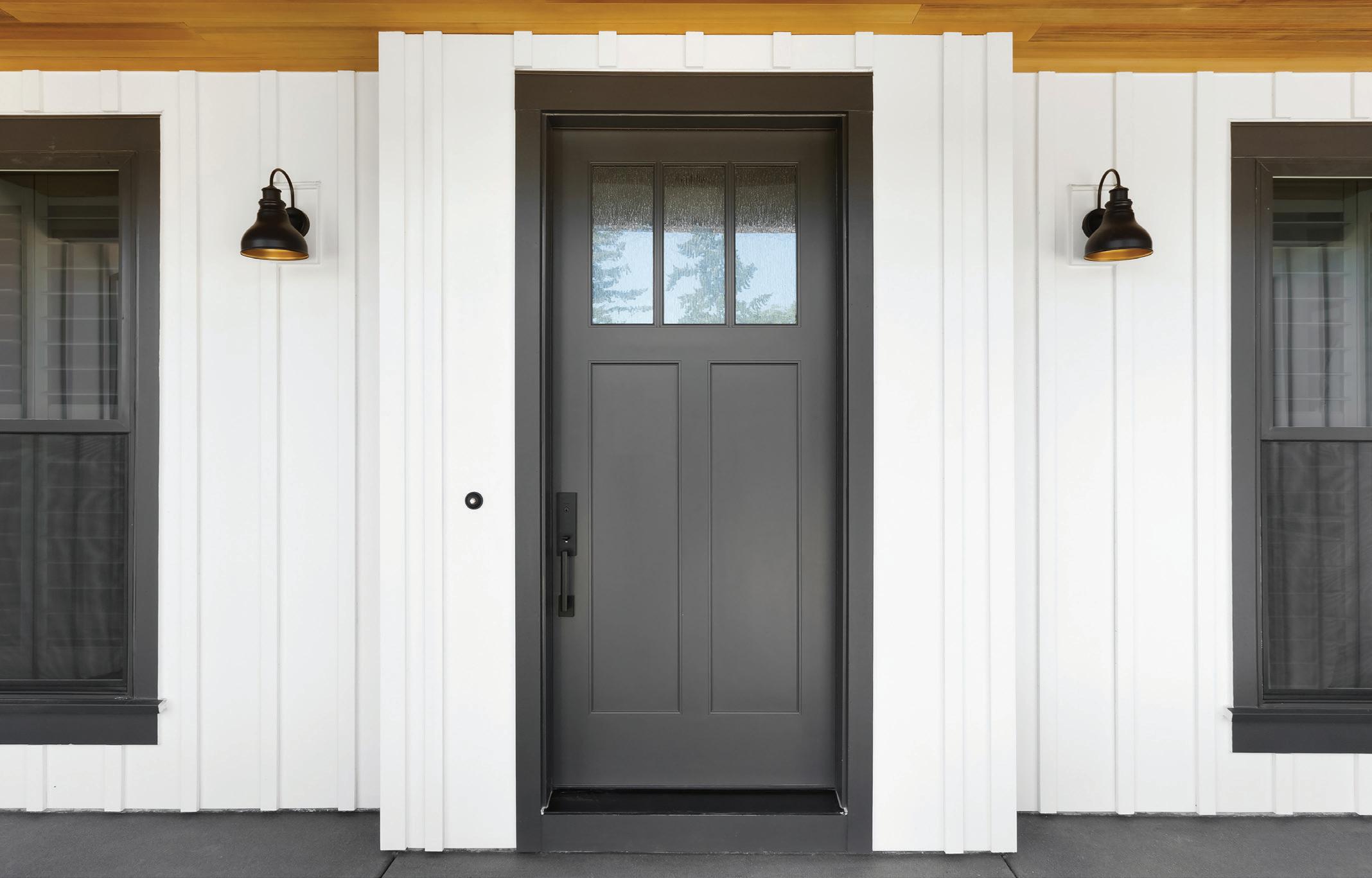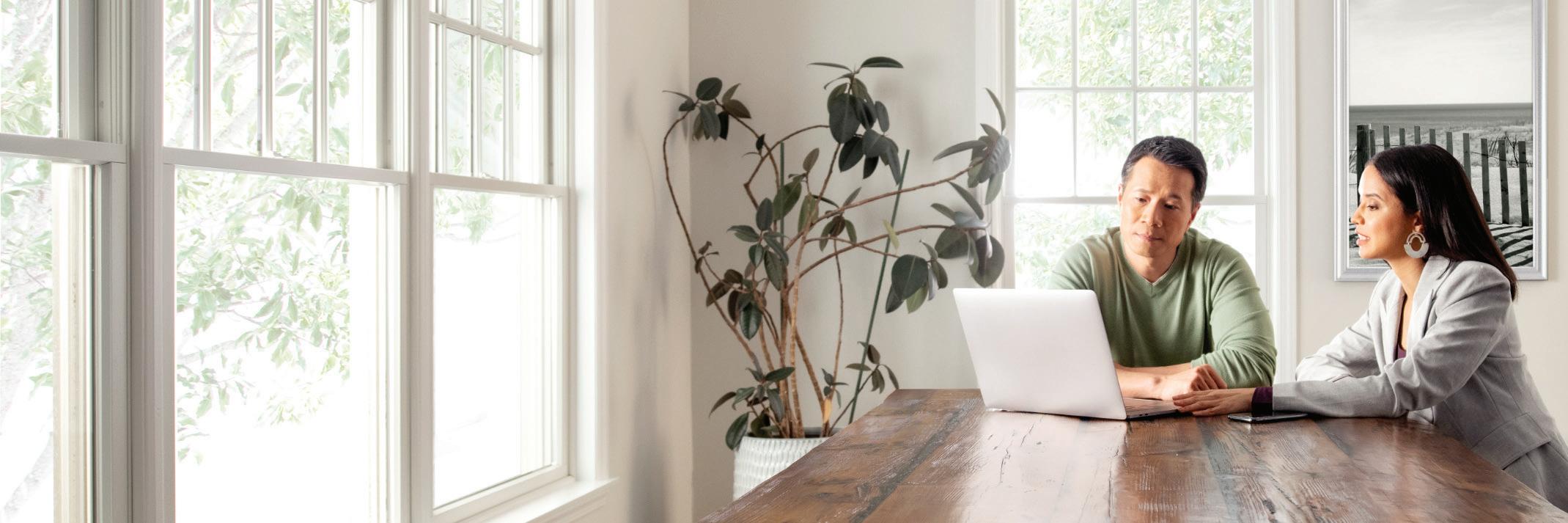Palouse LIVING



With housing supply at historic lows, homebuyers are increasingly turning to new construction. But this option is not without its pros and cons.
A big pro is that new homes are often more affordablethanexistinghomes.Andonthecon list,many buyers say they would prefer an older home with character. Complaints about new homes include bland builder-grade materials, limited color choices, and unremarkable finishes.
But fear not if you’re eyeing a new build. “You have a blank canvas to create a design masterpiece, and you aren’t restricted by aged materials or poor choices from the past,” says Blake Sutton, president of Est Est Interior Design,a firm based in Scottsdale,AZ.
If your new-construction home is more cookie cutter than custom, consider these six ways to add the charm, warmth, and character it needs.
A newly built home doesn’t have to be a characterless box.
One easy way to add depth and warmth is with wood tones in the cabinetry and flooring. You may also consider adding wood beams or a wood-panel treatment to a ceiling or a wood mantel if you have a fireplace.
Just be sure the wood tones are right for the style of your home.
“The wood tones that are appropriate are drastically different and are dependent on the style of the home,”says Sutton.
For instance, darker wood tones are best for a Spanish-style home, while a modern beach house should have much whiter wood tones.
Large developments will tend to use the same light fixtures across all the new homes. That’s because ordering in bulk cuts costs and can help avoid possible supply chain issues early.
But if you purchase a newly built home and want to make it feel special, lighting is an inexpensive upgrade on the scale of afterpurchase home improvements.And it can have a big impact.
“A great light fixture can bring a wow to a
foyer or dining room,” says New York interior designer Vicente Wolf, whose specialty is luxe, modern interiors.“It can be the focal point that can make or break a room.”
So what do older homes have that new homes don’t? Wood trim and molding.
If you’re handy, you can always add it yourself, or hire out the millwork if you’re not. Just be sure the trim you add is appropriate for the style of your home.
“It’s unlikely you will have crown molding in a new contemporary build,but you would in a traditional build,”says Sutton.
Molding should have a spare, streamlined profileinamodernhome.Thinkthick,straightedge baseboards devoid of frills painted in a nontraditional color.
“In a more modern space,color can go from silver leaf to a different tone,” explains Wolf. “Paint or stain adds richness to the space.”
Iftrim isn’t right for the lookand feel ofyour home,but you want to add some dimension to a room, consider creating a paneled statement wall behind a bed, in a home office, or in a
dining area. Pick a color that either sharply contrasts or completely blends into the room.

Installingacustomdoorisagreatwaytoadd curb appeal to an otherwise plain Jane house. This home (above) is newly built, but the wood entry door and posts create a charming experience before you even step inside.
Changing interior doors can also have a big impact.
Raising all door heights, for example, will make rooms appear larger and ceilings taller because they draw the gaze upward. You can also play tricks with doors that seem almost hidden in their surroundings.
“I love flush doors that disappear, with no molding around them,”says Wolf.“It gives an architectural feel to the space.”
One thing older homes have that resonates with homebuyers is antique hardware.
Luckily for new-home buyers, upgrading
builder-grade door knobs can have a big visual and tactile impact.
“A beautiful doorknob connects with your hand,andyoufeeltheweightandsolidquality,” saysWolf.“Beautifulhardwareaddsaluxurious, custom quality to a room.”
And luxury doesn’t necessarily mean ornate. A growing trend is quiet luxury, which emphasizes quality touches.
If you are considering a home in a new development and imagining ways to make it look and feel unique, avoid purchasing matching furniture sets.
A few well-placed antiques add gravitas to modern decor, and it’s especially needed in a home in a new development.
“Bringing a sense of the past gives character, depth, and a less thematic look to a modern space,”says Wolf.
So, ensure your home reflects your taste by taking your time to fill it with the things you love.











Realtor.com

If you’re a would-be seller, it might be thrilling to get an offer before your listing even goes online. Or better yet, you get an all-cash offer the very day it goes on the market. Wow! You might feel like the luckiest seller out there—until you realize it’s not a young homebuyer or a family purchasing your house but faceless real estate investors looking to turn your beloved home into a pricey rental or to tear it down.
There’s nothing inherently wrong with investors trying to make a buck in the real estatemarket.Butperhapsyou’resympathetic to the challenges facing first-time buyers and would like to pay forward the dream of homeownership that you experienced.
Here’s what to know about investors and how to know if one is making an offer on your home.
One of the biggest frustrations for all homebuyers right now is low inventory.And this affects sellers who will also need to find a new home, too. The U.S. has been underbuildingsincethehousingcrashof2008,and it’s now hitting a critical level.
“Over the last 10 years, the gap between single-family home construction (including multifamily housing) and household formations has grown to 2.3 million,” says Matthew Ricci,a Rhode Island–based home loan specialist for Churchill Mortgage. foreclosures.

Low home inventory and higher interest rates have somewhat cooled investor interest in recent months. But one type of investor is doubling down: small investors,defined as those owning fewer than 10 properties.
Small investors are often looking for the same type of home as first-time buyers: lower-priced starter homes. Investors generally buy these homes to rent out or to flip and sell at a profit.
“With the demand for rental housing continuing to rise, especially in urban areas
or regions with growing job opportunities, small landlords see an opportunity to capitalize on this demand and generate consistent rental income,”says Adam Garcia, founder and CEO ofThe Stock Dork.
But the result of growing rentals is even less housing inventory in the long run.
If you want to ensure that your singlefamily home is sold to a person or a family as their primary home,write it in your home description on your listing.
So how would you know if you are selling to an investor? The truth is that often it’s impossible to know. Some investment offers will come to you through a real estate professional,just like with any other buyer.
The best way to find out is to simply ask. If you are approached by a buyer’s agent, inquire upfront if the buyer is an investor or represents an investor.
Of course, the agent may or may not tell you who the buyer is.So here are some signs that you might be dealing with a real estate investor:

• A buyer approaches you by email or with a flyer left at your door.
• A buyer approaches you with an offer— before you list your home.


• You get an all-cash offer that’s significantly lower than the asking price.(Investors often underbid.)
• A buyer doesn’t care if the home is being sold as is.
• The buyer’s name on an offer is listed as an LLC or Inc.
You might also ask that all offers include a letter in which the buyers share their plans for the home.
If you have multiple bidders, when reviewing mortgage pre-approvals,you could give preference to buyers who have an FHA loan or VA loan. (These types of loans are often favored by first-time buyers as the financial requirements are less stringent than other loans.)
If you are genuinely resolved not to sell to an investor, put a deed restriction in the contract,which will limit what buyers can do to the home.

You should know that taking any of the above measures might mean possibly getting fewer offers,taking a longer time to sell,and maybe even making less profit on the sale of your home.
So you will have to weigh the pros and cons for yourself if you decide to not sell to an investor.
“Many investors offer cash and favorable terms for the seller, and that is what the sellers will focus on,”says Ricci.
Realtor.com
FHA versus conventional loan: If you need a mortgage to buy a house, you may find yourself weighing these two options. What’s the difference, and which one is right for you?
While the majority of homebuyers might assume they should get a conventional home loan, about 40% end up with FHA loans, which are insured by the Federal Housing Administration.
To help you decide whether an FHA or conventional loan is better for your circumstances, here’s more information about each, including their distinct advantages to you as a homebuyeraswellaswhatyou’llneed toqualify(whichmayvarybylender).
Conventionallenderslookforborrowers who have well-established credit scores, solid assets, and steady income, says Todd Sheinin, mortgage lender and chief operating officer at Homespire Mortgage in Gaithersburg, MD. As such, these loans have higher barriers to entry than the FHA-backed options. So you’d better have your A-game on!
Typically, you need at least a 620 credit score and ideally a 20% down payment, although you can put down as little as 3% if you so wish (this is generally reserved for first-time homebuyers).Just know that on any down payment under 20%, you’ll have to pay private mortgage insurance,an
extra monthly fee meant to mitigate the risk to the lender that you might default on your loan. (PMI ranges from about 0.58% to 1.86% of your home loan.)
Most conventional loans also require a maximum 50% debt-to-income ratio, which compares how much money you owe (on student loans, credit cards, car loans, and—hopefully soon—a home loan) with your income. So, for instance, if your household take-home income amounts to $5,000 per month, that would mean you should spend no more than $2,500 per month on your mortgage and other debts.
• Conventional loans don’t require mortgage insurance as long as you put down at least 20%.
• Conventional loans can cover higher loan amounts than FHA loans,which are restricted to county limits.
• Conventional loans, on average, are processed faster than FHA loans.

MINIMUM DOWN PAYMENT: 3.5%
MINIMUM CREDIT SCORE: 580
MAXIMUM DEBT-TOINCOME RATIO: 43%
FHA loans are great for first-time buyers or people without sterling credit or much money. Created by the Federal Housing Administration, these loans are insured by this government agency, so that guarantees that lenders won’t lose their money if borrowers default on their mortgage. In short, it allows lenders to take on riskier borrowers, while also helping hopeful home buyers in less-thanideal circumstances achieve the dream of homeownership.
at least a 3.5% down payment and a credit score of 580, says Tim Lucas, editor at MyMortgageInsider.com. Applicants with lower credit scores (e.g., 500) may not be out of the running entirely, but must cough up a larger down payment of at least 10%.
These loans also have debt-to-income requirements of less than 43%. So for example, if your monthly income is $5,000, your payments for your mortgage and other debts should not exceed $2,150.
FHAloansmaybeaboontohomebuyers (particularly first-timers) who might not qualify for a loan otherwise, but they do
Continued on page 7

MINIMUM DOWN PAYMENT: 3% TO 20% MINIMUM CREDIT SCORE: 620 MAXIMUM DEBTTO-INCOME RATIO: BELOW 50%

Realtor.com

Realtors® know a thing or two about cleaning. After all, showing houses can be a messy business. “There is constantly a dead bug that needs to be picked up, a shower head that was spraying out of the shower when a client tested it, or a kitchen counter that was left rather sticky,” says Callen Jones, who heads up the Jones Home Team in Florida’s Tampa Bay area.
That’s why we asked five different Realtors to share the cleaning products they reach for day after day.Here’s what they had to say.(Bonus:They’re all available at The Home Depot and less than $30 for all five products.)
“I love Magic Erasers. They’re a quick and easy way to get scuff marks off of walls to make them look fresh. Painting is best, but often sellers don’t have the exact paint colors anymore.” – Brooke Morton
“I always keep trash bags in my car for things I had going on for the week—from open-house signs to books and toys left behind by my son.My go-to brand is Hefty Ultra Strong,and I love the Fabuloso Scent. I never have to worry about these bags tearing because they are extremely durable.”
– Telia Rivers“I’m a sucker for anything lavender scented, and cleaning wipes are like the red lipstick of cleaning products: They can rectify a whole range of ills!” – Megan Kinealy-Hill FOR WHATEVER
YOU MIGHT FIND: LA’S TOTALLY AWESOME ALL-PURPOSE CLEANER SPRAY
“My go-to cleaning product is LA’s Totally Awesome yellow cleaner.It’s super affordable and works on so many different surfaces! Perfect for the ‘never know what
Continued on page 7


Continued from page 6 have a few disadvantages. For one, they’re usually capped at $472,030 (in certain highcost areas, the limit is $1,089,300)—meaning you may have limited buying power. Also, because the federal government insures these loans, you have to pay an upfront mortgage insurance premium (currently, the fee is about 1.75%) and annual mortgage insurance (typically 0.85% of the borrowed loan amount), which remains throughout the life of the loan (or until you can refinance the loan into a conventional mortgage).
Continued from page 5

• FHA loans have lower down payment requirements (3.5%).
• FHA loans have lower credit score requirements (as low as 580 for qualified bor borrowers).
• FHA loans have low DTI requirements of 43% or less.

Generally if you have the means and qualifications to afford a conventional loan, this is the one to opt for, since it has fewer restrictions (and is faster to get). However, if you’re a less-than-ideal homebuyer with a mediocre credit score, down payment, or income, then an FHA loan may be the best—or only—avenue open to you.


Check with your lender to know where you stand,or plug your numbers into an online
you’ll find’life of a Realtor.”— Callen Jones
“Bar Keeper’s Friend is a great cleaner especially for hard-to-clean areas in kitchens (including stainless steel appliances) or bathrooms.”– Glennie Kramer-Baker
















































